Effect of Vitamin D Supplementation on Muscle Strength, Frailty and Risk of Fall in Older People
VerifiedAdded on 2023/05/30
|11
|3220
|268
AI Summary
This paper explores the impact of Vitamin D supplementation on muscle strength, frailty and risk of fall in older people. It discusses the prevalence of Vitamin D deficiency among the elderly and its association with morbidity, reduced physical performance, decreased muscular strength, low cognitive ability, fractures, and falls. The paper recommends a 12-month Vitamin D supplementation program for residential older adults aged 65 years and above who are at high risk of low muscle strength, frailty and risk of fall. The program aims to reduce frailties, increase muscle strength and reduce the risk of fall.
Contribute Materials
Your contribution can guide someone’s learning journey. Share your
documents today.
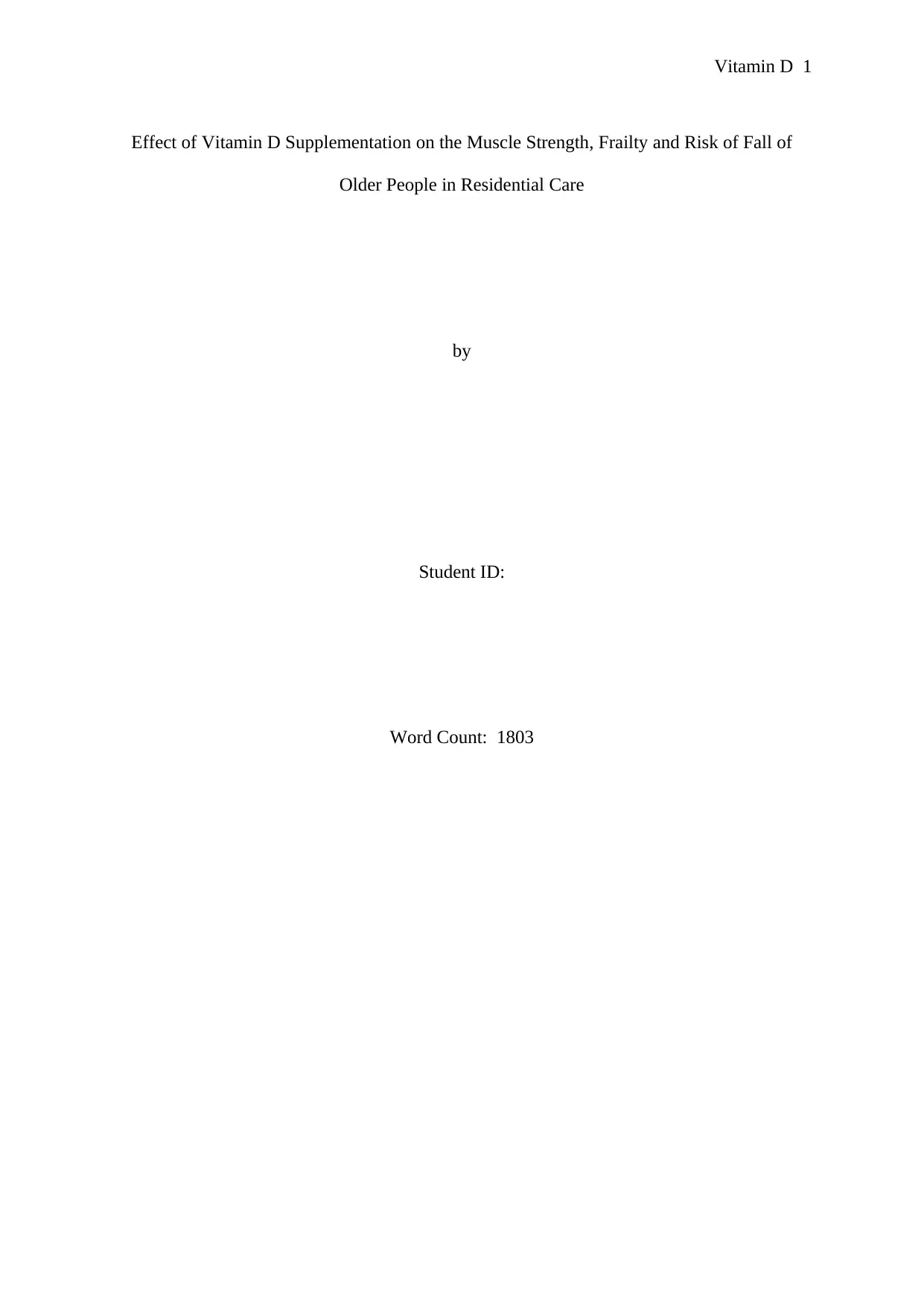
Vitamin D 1
Effect of Vitamin D Supplementation on the Muscle Strength, Frailty and Risk of Fall of
Older People in Residential Care
by
Student ID:
Word Count: 1803
Effect of Vitamin D Supplementation on the Muscle Strength, Frailty and Risk of Fall of
Older People in Residential Care
by
Student ID:
Word Count: 1803
Secure Best Marks with AI Grader
Need help grading? Try our AI Grader for instant feedback on your assignments.
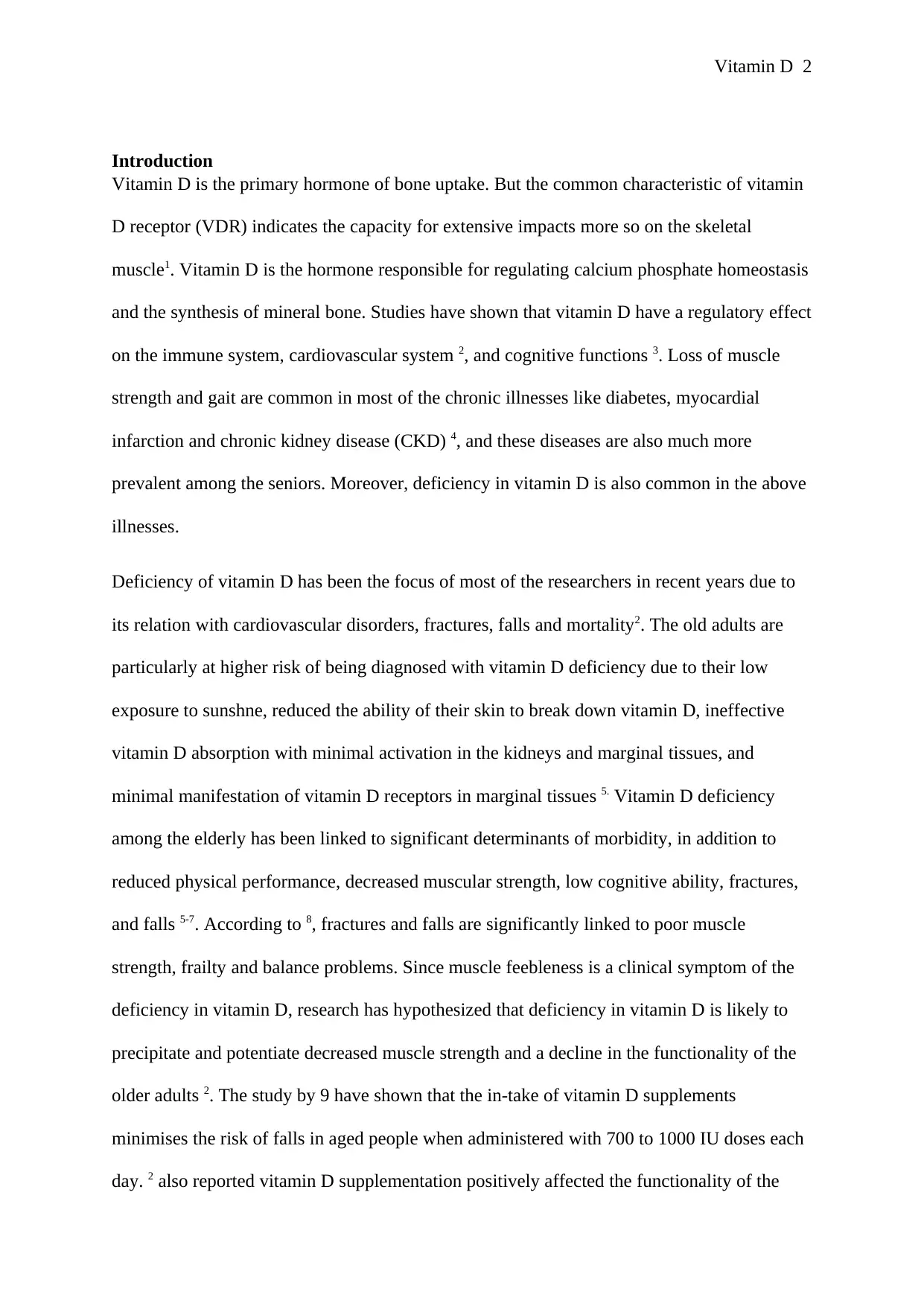
Vitamin D 2
Introduction
Vitamin D is the primary hormone of bone uptake. But the common characteristic of vitamin
D receptor (VDR) indicates the capacity for extensive impacts more so on the skeletal
muscle1. Vitamin D is the hormone responsible for regulating calcium phosphate homeostasis
and the synthesis of mineral bone. Studies have shown that vitamin D have a regulatory effect
on the immune system, cardiovascular system 2, and cognitive functions 3. Loss of muscle
strength and gait are common in most of the chronic illnesses like diabetes, myocardial
infarction and chronic kidney disease (CKD) 4, and these diseases are also much more
prevalent among the seniors. Moreover, deficiency in vitamin D is also common in the above
illnesses.
Deficiency of vitamin D has been the focus of most of the researchers in recent years due to
its relation with cardiovascular disorders, fractures, falls and mortality2. The old adults are
particularly at higher risk of being diagnosed with vitamin D deficiency due to their low
exposure to sunshne, reduced the ability of their skin to break down vitamin D, ineffective
vitamin D absorption with minimal activation in the kidneys and marginal tissues, and
minimal manifestation of vitamin D receptors in marginal tissues 5. Vitamin D deficiency
among the elderly has been linked to significant determinants of morbidity, in addition to
reduced physical performance, decreased muscular strength, low cognitive ability, fractures,
and falls 5-7. According to 8, fractures and falls are significantly linked to poor muscle
strength, frailty and balance problems. Since muscle feebleness is a clinical symptom of the
deficiency in vitamin D, research has hypothesized that deficiency in vitamin D is likely to
precipitate and potentiate decreased muscle strength and a decline in the functionality of the
older adults 2. The study by 9 have shown that the in-take of vitamin D supplements
minimises the risk of falls in aged people when administered with 700 to 1000 IU doses each
day. 2 also reported vitamin D supplementation positively affected the functionality of the
Introduction
Vitamin D is the primary hormone of bone uptake. But the common characteristic of vitamin
D receptor (VDR) indicates the capacity for extensive impacts more so on the skeletal
muscle1. Vitamin D is the hormone responsible for regulating calcium phosphate homeostasis
and the synthesis of mineral bone. Studies have shown that vitamin D have a regulatory effect
on the immune system, cardiovascular system 2, and cognitive functions 3. Loss of muscle
strength and gait are common in most of the chronic illnesses like diabetes, myocardial
infarction and chronic kidney disease (CKD) 4, and these diseases are also much more
prevalent among the seniors. Moreover, deficiency in vitamin D is also common in the above
illnesses.
Deficiency of vitamin D has been the focus of most of the researchers in recent years due to
its relation with cardiovascular disorders, fractures, falls and mortality2. The old adults are
particularly at higher risk of being diagnosed with vitamin D deficiency due to their low
exposure to sunshne, reduced the ability of their skin to break down vitamin D, ineffective
vitamin D absorption with minimal activation in the kidneys and marginal tissues, and
minimal manifestation of vitamin D receptors in marginal tissues 5. Vitamin D deficiency
among the elderly has been linked to significant determinants of morbidity, in addition to
reduced physical performance, decreased muscular strength, low cognitive ability, fractures,
and falls 5-7. According to 8, fractures and falls are significantly linked to poor muscle
strength, frailty and balance problems. Since muscle feebleness is a clinical symptom of the
deficiency in vitamin D, research has hypothesized that deficiency in vitamin D is likely to
precipitate and potentiate decreased muscle strength and a decline in the functionality of the
older adults 2. The study by 9 have shown that the in-take of vitamin D supplements
minimises the risk of falls in aged people when administered with 700 to 1000 IU doses each
day. 2 also reported vitamin D supplementation positively affected the functionality of the
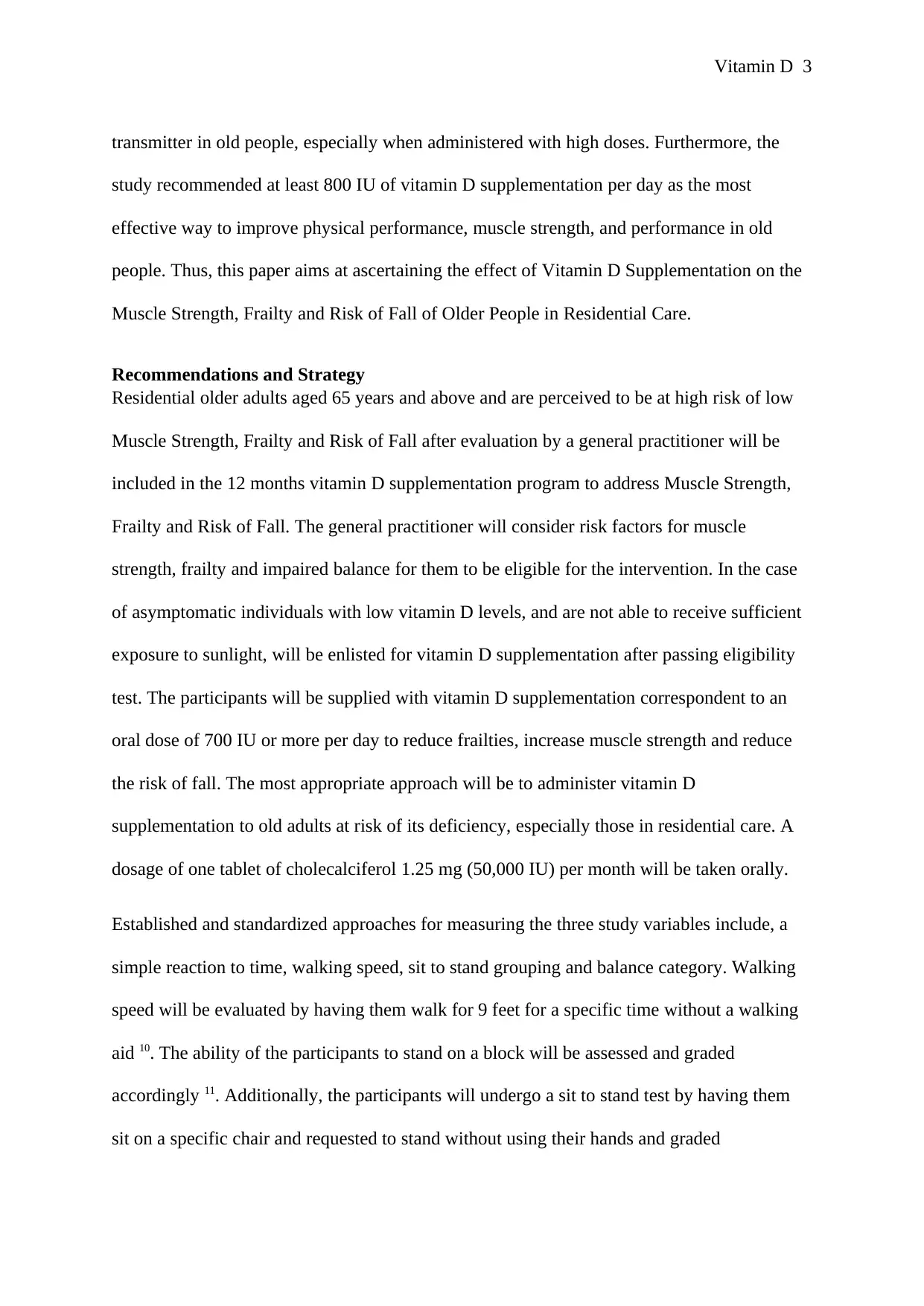
Vitamin D 3
transmitter in old people, especially when administered with high doses. Furthermore, the
study recommended at least 800 IU of vitamin D supplementation per day as the most
effective way to improve physical performance, muscle strength, and performance in old
people. Thus, this paper aims at ascertaining the effect of Vitamin D Supplementation on the
Muscle Strength, Frailty and Risk of Fall of Older People in Residential Care.
Recommendations and Strategy
Residential older adults aged 65 years and above and are perceived to be at high risk of low
Muscle Strength, Frailty and Risk of Fall after evaluation by a general practitioner will be
included in the 12 months vitamin D supplementation program to address Muscle Strength,
Frailty and Risk of Fall. The general practitioner will consider risk factors for muscle
strength, frailty and impaired balance for them to be eligible for the intervention. In the case
of asymptomatic individuals with low vitamin D levels, and are not able to receive sufficient
exposure to sunlight, will be enlisted for vitamin D supplementation after passing eligibility
test. The participants will be supplied with vitamin D supplementation correspondent to an
oral dose of 700 IU or more per day to reduce frailties, increase muscle strength and reduce
the risk of fall. The most appropriate approach will be to administer vitamin D
supplementation to old adults at risk of its deficiency, especially those in residential care. A
dosage of one tablet of cholecalciferol 1.25 mg (50,000 IU) per month will be taken orally.
Established and standardized approaches for measuring the three study variables include, a
simple reaction to time, walking speed, sit to stand grouping and balance category. Walking
speed will be evaluated by having them walk for 9 feet for a specific time without a walking
aid 10. The ability of the participants to stand on a block will be assessed and graded
accordingly 11. Additionally, the participants will undergo a sit to stand test by having them
sit on a specific chair and requested to stand without using their hands and graded
transmitter in old people, especially when administered with high doses. Furthermore, the
study recommended at least 800 IU of vitamin D supplementation per day as the most
effective way to improve physical performance, muscle strength, and performance in old
people. Thus, this paper aims at ascertaining the effect of Vitamin D Supplementation on the
Muscle Strength, Frailty and Risk of Fall of Older People in Residential Care.
Recommendations and Strategy
Residential older adults aged 65 years and above and are perceived to be at high risk of low
Muscle Strength, Frailty and Risk of Fall after evaluation by a general practitioner will be
included in the 12 months vitamin D supplementation program to address Muscle Strength,
Frailty and Risk of Fall. The general practitioner will consider risk factors for muscle
strength, frailty and impaired balance for them to be eligible for the intervention. In the case
of asymptomatic individuals with low vitamin D levels, and are not able to receive sufficient
exposure to sunlight, will be enlisted for vitamin D supplementation after passing eligibility
test. The participants will be supplied with vitamin D supplementation correspondent to an
oral dose of 700 IU or more per day to reduce frailties, increase muscle strength and reduce
the risk of fall. The most appropriate approach will be to administer vitamin D
supplementation to old adults at risk of its deficiency, especially those in residential care. A
dosage of one tablet of cholecalciferol 1.25 mg (50,000 IU) per month will be taken orally.
Established and standardized approaches for measuring the three study variables include, a
simple reaction to time, walking speed, sit to stand grouping and balance category. Walking
speed will be evaluated by having them walk for 9 feet for a specific time without a walking
aid 10. The ability of the participants to stand on a block will be assessed and graded
accordingly 11. Additionally, the participants will undergo a sit to stand test by having them
sit on a specific chair and requested to stand without using their hands and graded
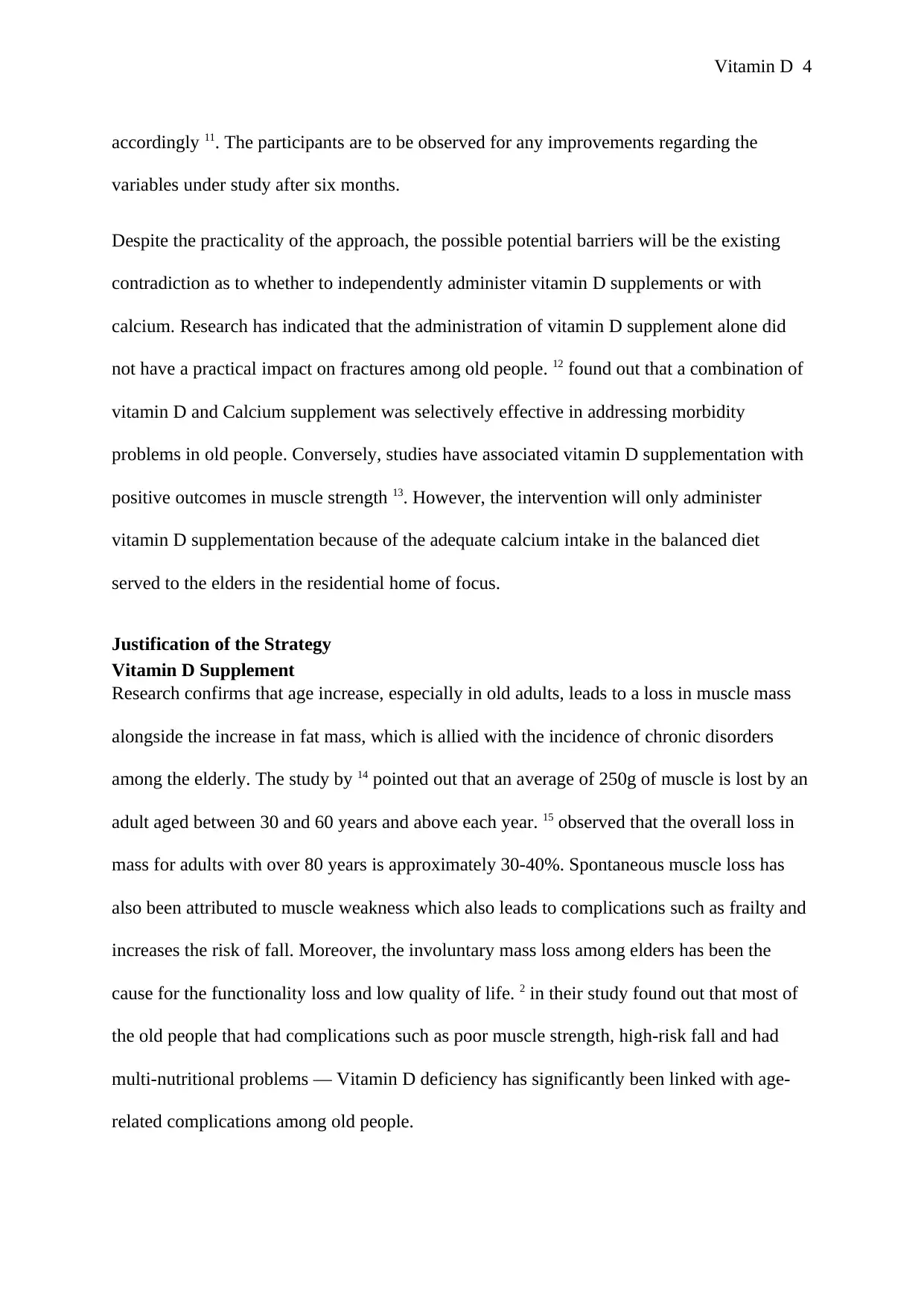
Vitamin D 4
accordingly 11. The participants are to be observed for any improvements regarding the
variables under study after six months.
Despite the practicality of the approach, the possible potential barriers will be the existing
contradiction as to whether to independently administer vitamin D supplements or with
calcium. Research has indicated that the administration of vitamin D supplement alone did
not have a practical impact on fractures among old people. 12 found out that a combination of
vitamin D and Calcium supplement was selectively effective in addressing morbidity
problems in old people. Conversely, studies have associated vitamin D supplementation with
positive outcomes in muscle strength 13. However, the intervention will only administer
vitamin D supplementation because of the adequate calcium intake in the balanced diet
served to the elders in the residential home of focus.
Justification of the Strategy
Vitamin D Supplement
Research confirms that age increase, especially in old adults, leads to a loss in muscle mass
alongside the increase in fat mass, which is allied with the incidence of chronic disorders
among the elderly. The study by 14 pointed out that an average of 250g of muscle is lost by an
adult aged between 30 and 60 years and above each year. 15 observed that the overall loss in
mass for adults with over 80 years is approximately 30-40%. Spontaneous muscle loss has
also been attributed to muscle weakness which also leads to complications such as frailty and
increases the risk of fall. Moreover, the involuntary mass loss among elders has been the
cause for the functionality loss and low quality of life. 2 in their study found out that most of
the old people that had complications such as poor muscle strength, high-risk fall and had
multi-nutritional problems — Vitamin D deficiency has significantly been linked with age-
related complications among old people.
accordingly 11. The participants are to be observed for any improvements regarding the
variables under study after six months.
Despite the practicality of the approach, the possible potential barriers will be the existing
contradiction as to whether to independently administer vitamin D supplements or with
calcium. Research has indicated that the administration of vitamin D supplement alone did
not have a practical impact on fractures among old people. 12 found out that a combination of
vitamin D and Calcium supplement was selectively effective in addressing morbidity
problems in old people. Conversely, studies have associated vitamin D supplementation with
positive outcomes in muscle strength 13. However, the intervention will only administer
vitamin D supplementation because of the adequate calcium intake in the balanced diet
served to the elders in the residential home of focus.
Justification of the Strategy
Vitamin D Supplement
Research confirms that age increase, especially in old adults, leads to a loss in muscle mass
alongside the increase in fat mass, which is allied with the incidence of chronic disorders
among the elderly. The study by 14 pointed out that an average of 250g of muscle is lost by an
adult aged between 30 and 60 years and above each year. 15 observed that the overall loss in
mass for adults with over 80 years is approximately 30-40%. Spontaneous muscle loss has
also been attributed to muscle weakness which also leads to complications such as frailty and
increases the risk of fall. Moreover, the involuntary mass loss among elders has been the
cause for the functionality loss and low quality of life. 2 in their study found out that most of
the old people that had complications such as poor muscle strength, high-risk fall and had
multi-nutritional problems — Vitamin D deficiency has significantly been linked with age-
related complications among old people.
Secure Best Marks with AI Grader
Need help grading? Try our AI Grader for instant feedback on your assignments.
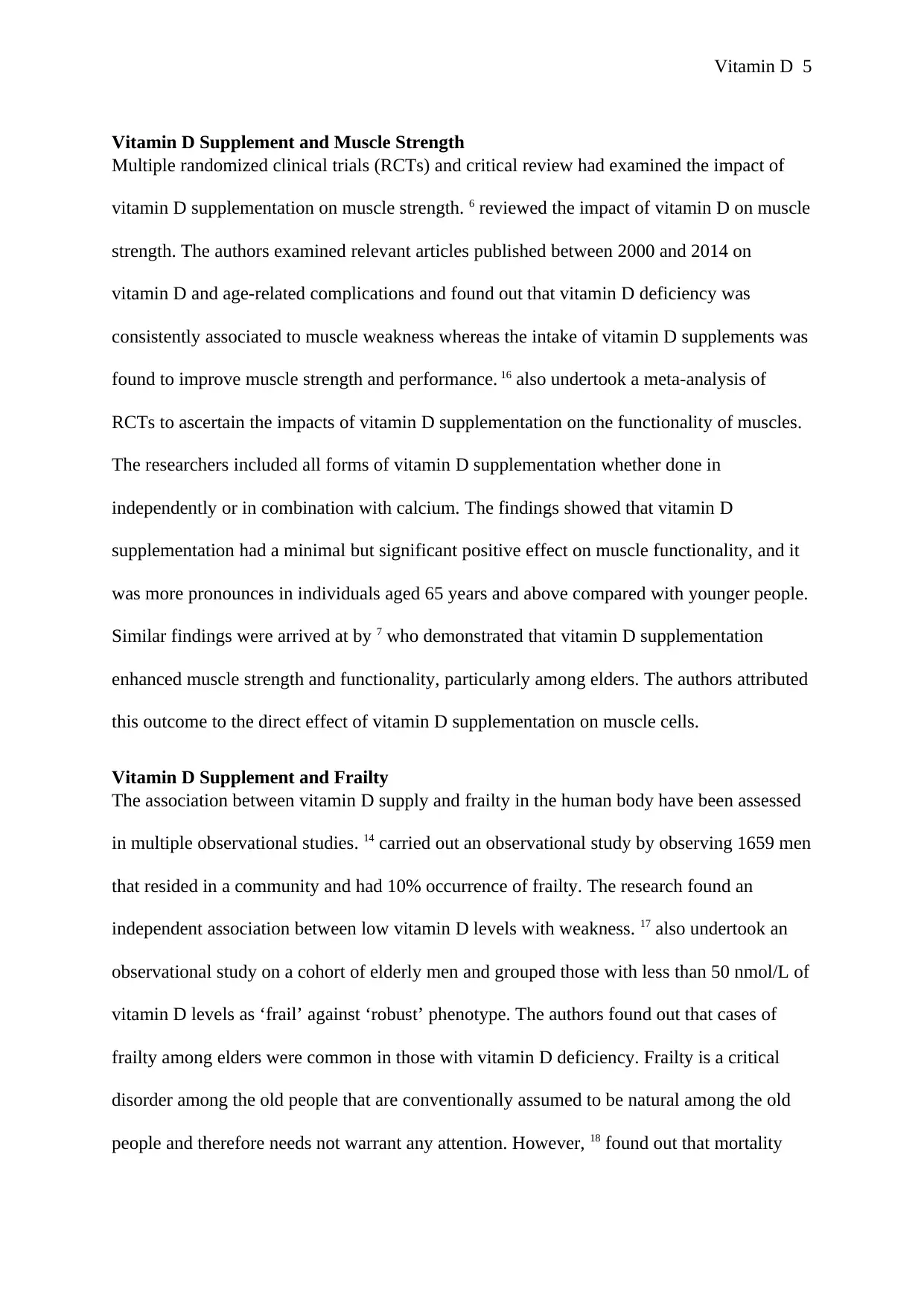
Vitamin D 5
Vitamin D Supplement and Muscle Strength
Multiple randomized clinical trials (RCTs) and critical review had examined the impact of
vitamin D supplementation on muscle strength. 6 reviewed the impact of vitamin D on muscle
strength. The authors examined relevant articles published between 2000 and 2014 on
vitamin D and age-related complications and found out that vitamin D deficiency was
consistently associated to muscle weakness whereas the intake of vitamin D supplements was
found to improve muscle strength and performance. 16 also undertook a meta-analysis of
RCTs to ascertain the impacts of vitamin D supplementation on the functionality of muscles.
The researchers included all forms of vitamin D supplementation whether done in
independently or in combination with calcium. The findings showed that vitamin D
supplementation had a minimal but significant positive effect on muscle functionality, and it
was more pronounces in individuals aged 65 years and above compared with younger people.
Similar findings were arrived at by 7 who demonstrated that vitamin D supplementation
enhanced muscle strength and functionality, particularly among elders. The authors attributed
this outcome to the direct effect of vitamin D supplementation on muscle cells.
Vitamin D Supplement and Frailty
The association between vitamin D supply and frailty in the human body have been assessed
in multiple observational studies. 14 carried out an observational study by observing 1659 men
that resided in a community and had 10% occurrence of frailty. The research found an
independent association between low vitamin D levels with weakness. 17 also undertook an
observational study on a cohort of elderly men and grouped those with less than 50 nmol/L of
vitamin D levels as ‘frail’ against ‘robust’ phenotype. The authors found out that cases of
frailty among elders were common in those with vitamin D deficiency. Frailty is a critical
disorder among the old people that are conventionally assumed to be natural among the old
people and therefore needs not warrant any attention. However, 18 found out that mortality
Vitamin D Supplement and Muscle Strength
Multiple randomized clinical trials (RCTs) and critical review had examined the impact of
vitamin D supplementation on muscle strength. 6 reviewed the impact of vitamin D on muscle
strength. The authors examined relevant articles published between 2000 and 2014 on
vitamin D and age-related complications and found out that vitamin D deficiency was
consistently associated to muscle weakness whereas the intake of vitamin D supplements was
found to improve muscle strength and performance. 16 also undertook a meta-analysis of
RCTs to ascertain the impacts of vitamin D supplementation on the functionality of muscles.
The researchers included all forms of vitamin D supplementation whether done in
independently or in combination with calcium. The findings showed that vitamin D
supplementation had a minimal but significant positive effect on muscle functionality, and it
was more pronounces in individuals aged 65 years and above compared with younger people.
Similar findings were arrived at by 7 who demonstrated that vitamin D supplementation
enhanced muscle strength and functionality, particularly among elders. The authors attributed
this outcome to the direct effect of vitamin D supplementation on muscle cells.
Vitamin D Supplement and Frailty
The association between vitamin D supply and frailty in the human body have been assessed
in multiple observational studies. 14 carried out an observational study by observing 1659 men
that resided in a community and had 10% occurrence of frailty. The research found an
independent association between low vitamin D levels with weakness. 17 also undertook an
observational study on a cohort of elderly men and grouped those with less than 50 nmol/L of
vitamin D levels as ‘frail’ against ‘robust’ phenotype. The authors found out that cases of
frailty among elders were common in those with vitamin D deficiency. Frailty is a critical
disorder among the old people that are conventionally assumed to be natural among the old
people and therefore needs not warrant any attention. However, 18 found out that mortality
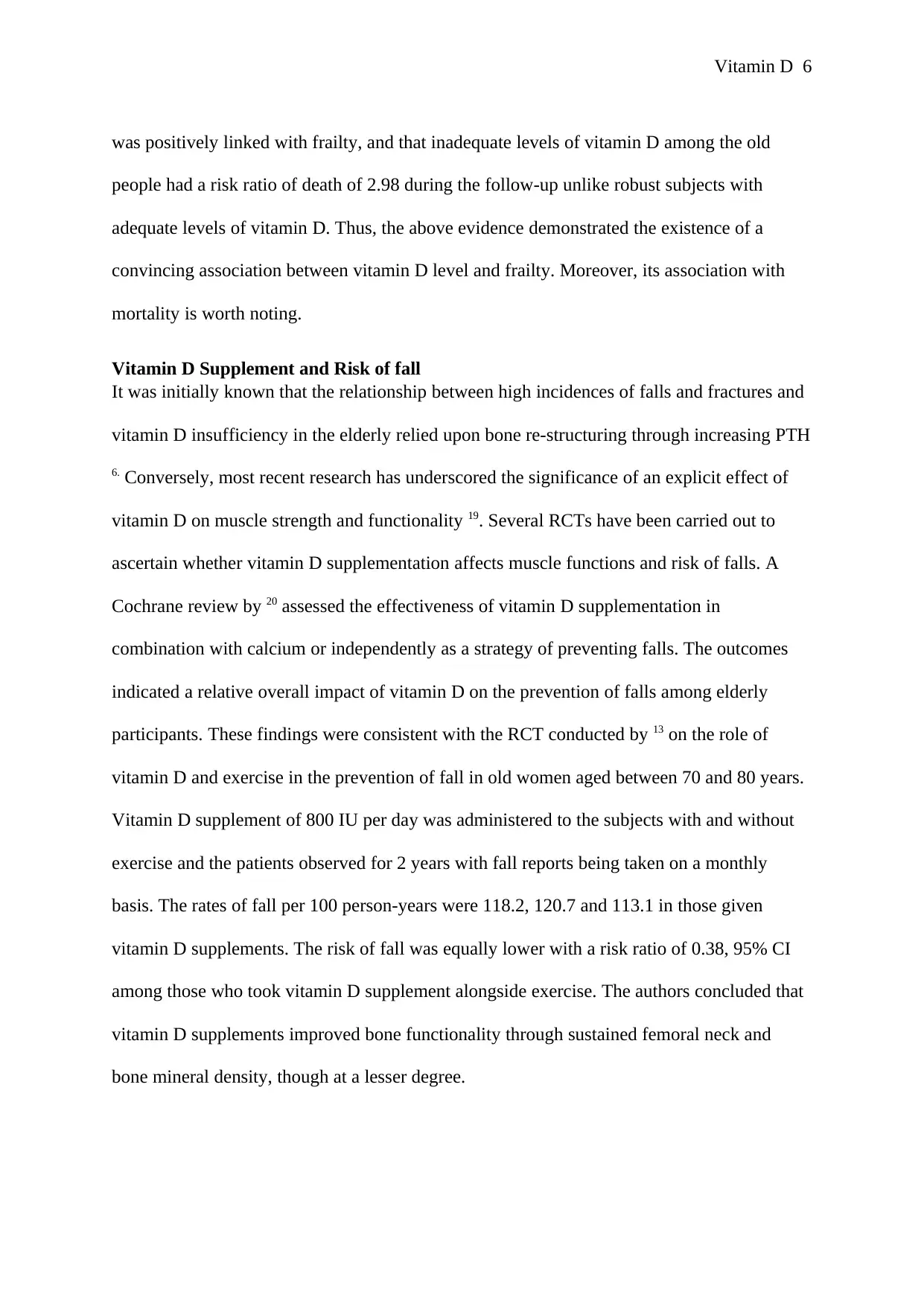
Vitamin D 6
was positively linked with frailty, and that inadequate levels of vitamin D among the old
people had a risk ratio of death of 2.98 during the follow-up unlike robust subjects with
adequate levels of vitamin D. Thus, the above evidence demonstrated the existence of a
convincing association between vitamin D level and frailty. Moreover, its association with
mortality is worth noting.
Vitamin D Supplement and Risk of fall
It was initially known that the relationship between high incidences of falls and fractures and
vitamin D insufficiency in the elderly relied upon bone re-structuring through increasing PTH
6. Conversely, most recent research has underscored the significance of an explicit effect of
vitamin D on muscle strength and functionality 19. Several RCTs have been carried out to
ascertain whether vitamin D supplementation affects muscle functions and risk of falls. A
Cochrane review by 20 assessed the effectiveness of vitamin D supplementation in
combination with calcium or independently as a strategy of preventing falls. The outcomes
indicated a relative overall impact of vitamin D on the prevention of falls among elderly
participants. These findings were consistent with the RCT conducted by 13 on the role of
vitamin D and exercise in the prevention of fall in old women aged between 70 and 80 years.
Vitamin D supplement of 800 IU per day was administered to the subjects with and without
exercise and the patients observed for 2 years with fall reports being taken on a monthly
basis. The rates of fall per 100 person-years were 118.2, 120.7 and 113.1 in those given
vitamin D supplements. The risk of fall was equally lower with a risk ratio of 0.38, 95% CI
among those who took vitamin D supplement alongside exercise. The authors concluded that
vitamin D supplements improved bone functionality through sustained femoral neck and
bone mineral density, though at a lesser degree.
was positively linked with frailty, and that inadequate levels of vitamin D among the old
people had a risk ratio of death of 2.98 during the follow-up unlike robust subjects with
adequate levels of vitamin D. Thus, the above evidence demonstrated the existence of a
convincing association between vitamin D level and frailty. Moreover, its association with
mortality is worth noting.
Vitamin D Supplement and Risk of fall
It was initially known that the relationship between high incidences of falls and fractures and
vitamin D insufficiency in the elderly relied upon bone re-structuring through increasing PTH
6. Conversely, most recent research has underscored the significance of an explicit effect of
vitamin D on muscle strength and functionality 19. Several RCTs have been carried out to
ascertain whether vitamin D supplementation affects muscle functions and risk of falls. A
Cochrane review by 20 assessed the effectiveness of vitamin D supplementation in
combination with calcium or independently as a strategy of preventing falls. The outcomes
indicated a relative overall impact of vitamin D on the prevention of falls among elderly
participants. These findings were consistent with the RCT conducted by 13 on the role of
vitamin D and exercise in the prevention of fall in old women aged between 70 and 80 years.
Vitamin D supplement of 800 IU per day was administered to the subjects with and without
exercise and the patients observed for 2 years with fall reports being taken on a monthly
basis. The rates of fall per 100 person-years were 118.2, 120.7 and 113.1 in those given
vitamin D supplements. The risk of fall was equally lower with a risk ratio of 0.38, 95% CI
among those who took vitamin D supplement alongside exercise. The authors concluded that
vitamin D supplements improved bone functionality through sustained femoral neck and
bone mineral density, though at a lesser degree.
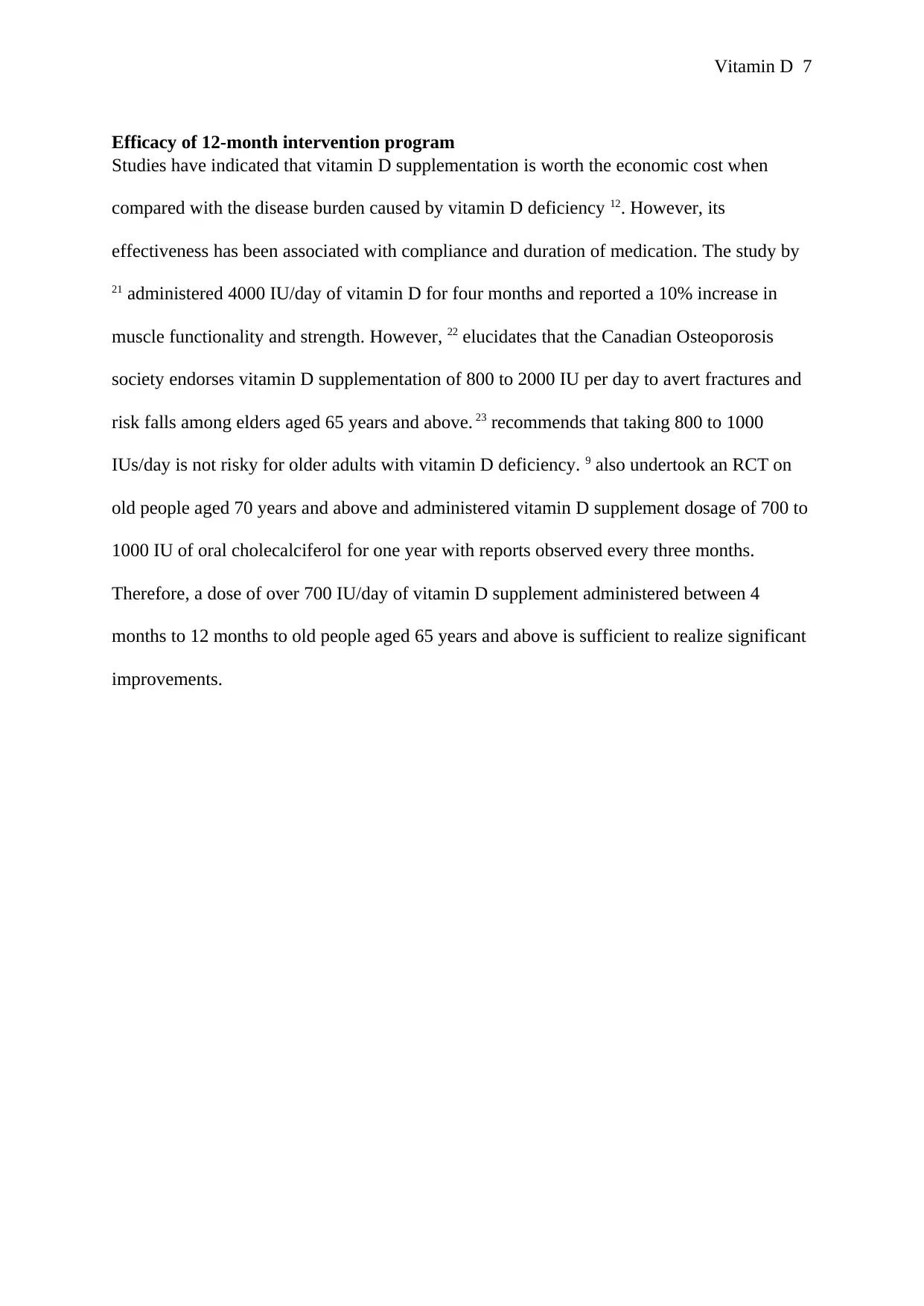
Vitamin D 7
Efficacy of 12-month intervention program
Studies have indicated that vitamin D supplementation is worth the economic cost when
compared with the disease burden caused by vitamin D deficiency 12. However, its
effectiveness has been associated with compliance and duration of medication. The study by
21 administered 4000 IU/day of vitamin D for four months and reported a 10% increase in
muscle functionality and strength. However, 22 elucidates that the Canadian Osteoporosis
society endorses vitamin D supplementation of 800 to 2000 IU per day to avert fractures and
risk falls among elders aged 65 years and above. 23 recommends that taking 800 to 1000
IUs/day is not risky for older adults with vitamin D deficiency. 9 also undertook an RCT on
old people aged 70 years and above and administered vitamin D supplement dosage of 700 to
1000 IU of oral cholecalciferol for one year with reports observed every three months.
Therefore, a dose of over 700 IU/day of vitamin D supplement administered between 4
months to 12 months to old people aged 65 years and above is sufficient to realize significant
improvements.
Efficacy of 12-month intervention program
Studies have indicated that vitamin D supplementation is worth the economic cost when
compared with the disease burden caused by vitamin D deficiency 12. However, its
effectiveness has been associated with compliance and duration of medication. The study by
21 administered 4000 IU/day of vitamin D for four months and reported a 10% increase in
muscle functionality and strength. However, 22 elucidates that the Canadian Osteoporosis
society endorses vitamin D supplementation of 800 to 2000 IU per day to avert fractures and
risk falls among elders aged 65 years and above. 23 recommends that taking 800 to 1000
IUs/day is not risky for older adults with vitamin D deficiency. 9 also undertook an RCT on
old people aged 70 years and above and administered vitamin D supplement dosage of 700 to
1000 IU of oral cholecalciferol for one year with reports observed every three months.
Therefore, a dose of over 700 IU/day of vitamin D supplement administered between 4
months to 12 months to old people aged 65 years and above is sufficient to realize significant
improvements.
Paraphrase This Document
Need a fresh take? Get an instant paraphrase of this document with our AI Paraphraser
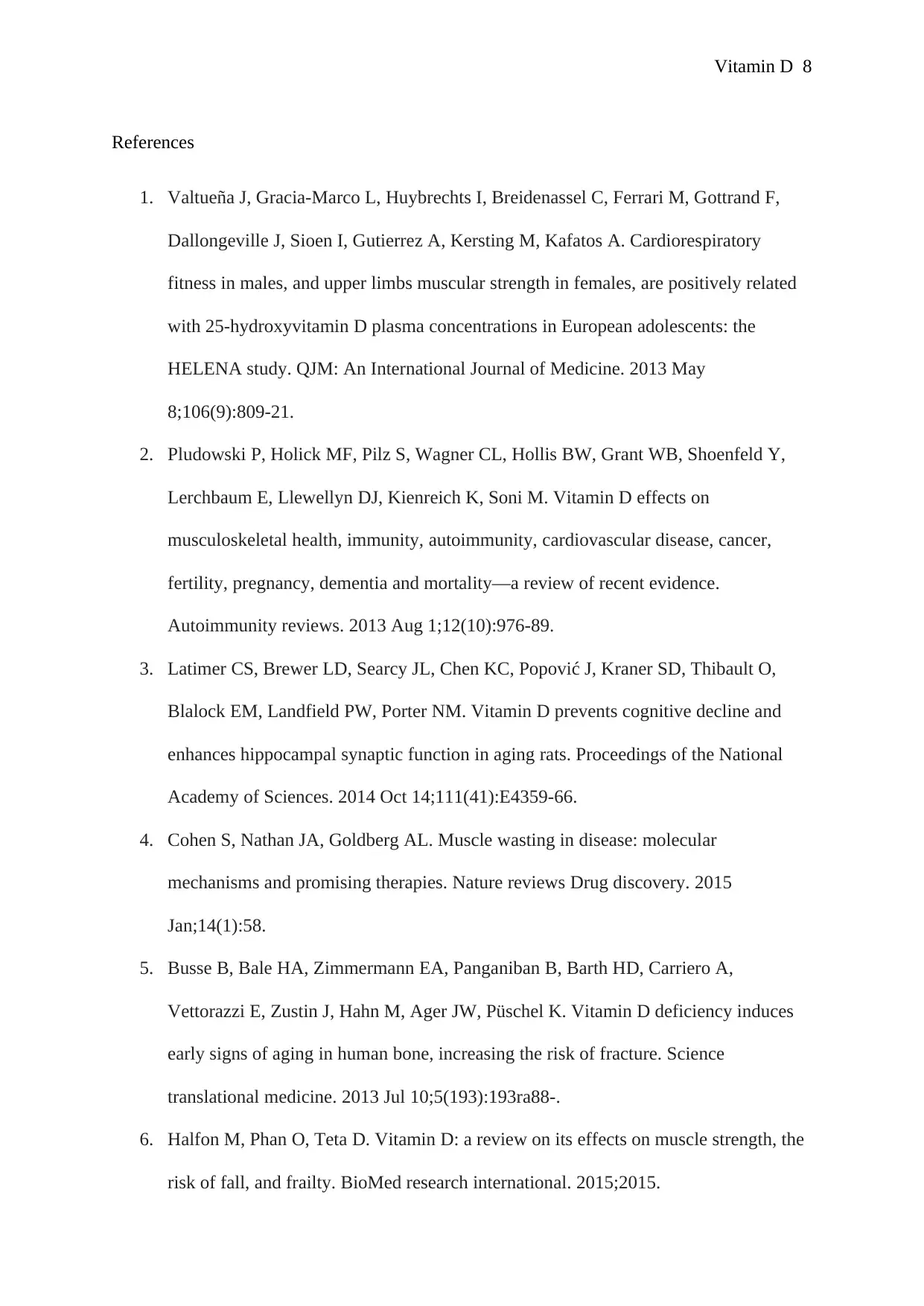
Vitamin D 8
References
1. Valtueña J, Gracia-Marco L, Huybrechts I, Breidenassel C, Ferrari M, Gottrand F,
Dallongeville J, Sioen I, Gutierrez A, Kersting M, Kafatos A. Cardiorespiratory
fitness in males, and upper limbs muscular strength in females, are positively related
with 25-hydroxyvitamin D plasma concentrations in European adolescents: the
HELENA study. QJM: An International Journal of Medicine. 2013 May
8;106(9):809-21.
2. Pludowski P, Holick MF, Pilz S, Wagner CL, Hollis BW, Grant WB, Shoenfeld Y,
Lerchbaum E, Llewellyn DJ, Kienreich K, Soni M. Vitamin D effects on
musculoskeletal health, immunity, autoimmunity, cardiovascular disease, cancer,
fertility, pregnancy, dementia and mortality—a review of recent evidence.
Autoimmunity reviews. 2013 Aug 1;12(10):976-89.
3. Latimer CS, Brewer LD, Searcy JL, Chen KC, Popović J, Kraner SD, Thibault O,
Blalock EM, Landfield PW, Porter NM. Vitamin D prevents cognitive decline and
enhances hippocampal synaptic function in aging rats. Proceedings of the National
Academy of Sciences. 2014 Oct 14;111(41):E4359-66.
4. Cohen S, Nathan JA, Goldberg AL. Muscle wasting in disease: molecular
mechanisms and promising therapies. Nature reviews Drug discovery. 2015
Jan;14(1):58.
5. Busse B, Bale HA, Zimmermann EA, Panganiban B, Barth HD, Carriero A,
Vettorazzi E, Zustin J, Hahn M, Ager JW, Püschel K. Vitamin D deficiency induces
early signs of aging in human bone, increasing the risk of fracture. Science
translational medicine. 2013 Jul 10;5(193):193ra88-.
6. Halfon M, Phan O, Teta D. Vitamin D: a review on its effects on muscle strength, the
risk of fall, and frailty. BioMed research international. 2015;2015.
References
1. Valtueña J, Gracia-Marco L, Huybrechts I, Breidenassel C, Ferrari M, Gottrand F,
Dallongeville J, Sioen I, Gutierrez A, Kersting M, Kafatos A. Cardiorespiratory
fitness in males, and upper limbs muscular strength in females, are positively related
with 25-hydroxyvitamin D plasma concentrations in European adolescents: the
HELENA study. QJM: An International Journal of Medicine. 2013 May
8;106(9):809-21.
2. Pludowski P, Holick MF, Pilz S, Wagner CL, Hollis BW, Grant WB, Shoenfeld Y,
Lerchbaum E, Llewellyn DJ, Kienreich K, Soni M. Vitamin D effects on
musculoskeletal health, immunity, autoimmunity, cardiovascular disease, cancer,
fertility, pregnancy, dementia and mortality—a review of recent evidence.
Autoimmunity reviews. 2013 Aug 1;12(10):976-89.
3. Latimer CS, Brewer LD, Searcy JL, Chen KC, Popović J, Kraner SD, Thibault O,
Blalock EM, Landfield PW, Porter NM. Vitamin D prevents cognitive decline and
enhances hippocampal synaptic function in aging rats. Proceedings of the National
Academy of Sciences. 2014 Oct 14;111(41):E4359-66.
4. Cohen S, Nathan JA, Goldberg AL. Muscle wasting in disease: molecular
mechanisms and promising therapies. Nature reviews Drug discovery. 2015
Jan;14(1):58.
5. Busse B, Bale HA, Zimmermann EA, Panganiban B, Barth HD, Carriero A,
Vettorazzi E, Zustin J, Hahn M, Ager JW, Püschel K. Vitamin D deficiency induces
early signs of aging in human bone, increasing the risk of fracture. Science
translational medicine. 2013 Jul 10;5(193):193ra88-.
6. Halfon M, Phan O, Teta D. Vitamin D: a review on its effects on muscle strength, the
risk of fall, and frailty. BioMed research international. 2015;2015.
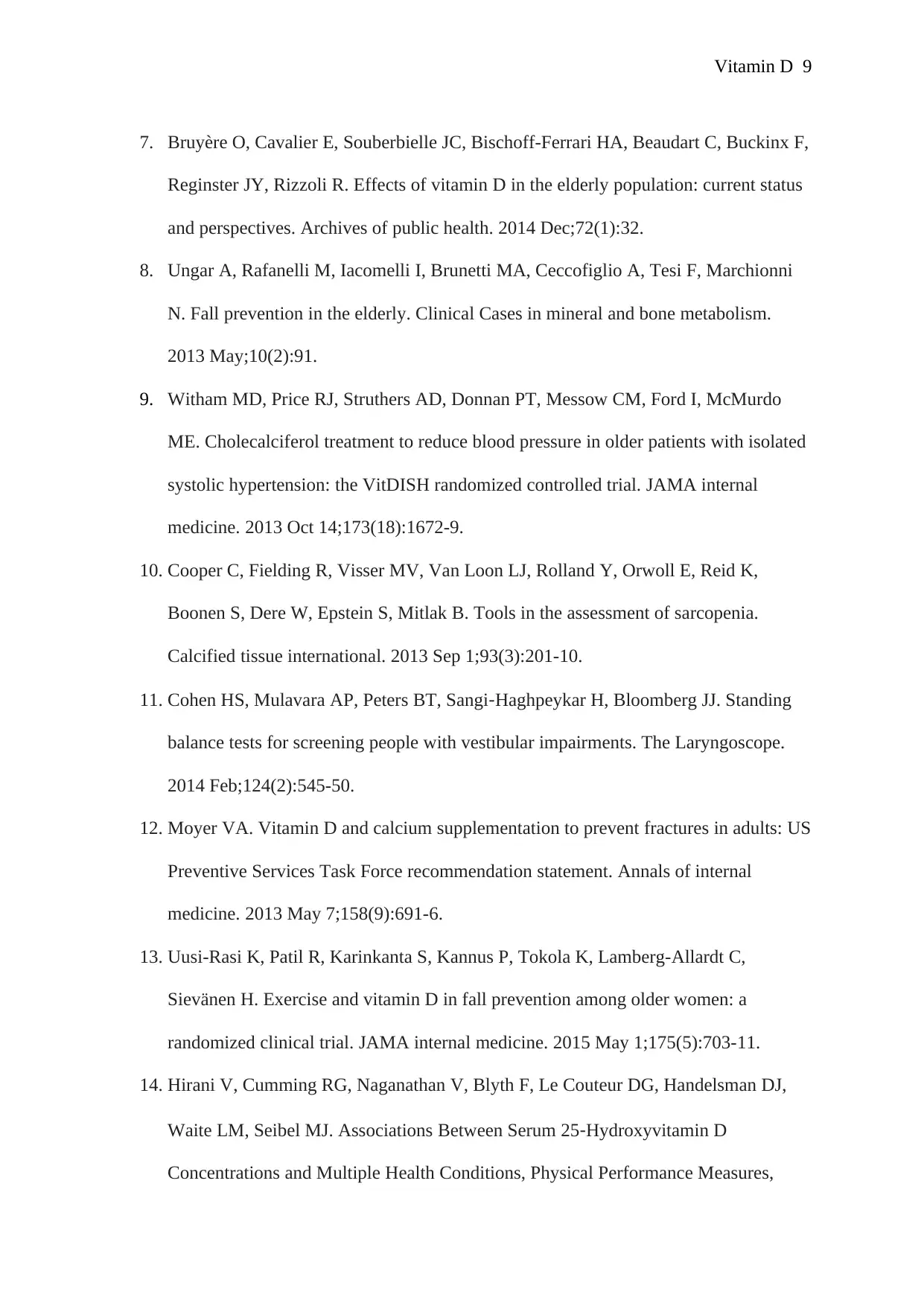
Vitamin D 9
7. Bruyère O, Cavalier E, Souberbielle JC, Bischoff-Ferrari HA, Beaudart C, Buckinx F,
Reginster JY, Rizzoli R. Effects of vitamin D in the elderly population: current status
and perspectives. Archives of public health. 2014 Dec;72(1):32.
8. Ungar A, Rafanelli M, Iacomelli I, Brunetti MA, Ceccofiglio A, Tesi F, Marchionni
N. Fall prevention in the elderly. Clinical Cases in mineral and bone metabolism.
2013 May;10(2):91.
9. Witham MD, Price RJ, Struthers AD, Donnan PT, Messow CM, Ford I, McMurdo
ME. Cholecalciferol treatment to reduce blood pressure in older patients with isolated
systolic hypertension: the VitDISH randomized controlled trial. JAMA internal
medicine. 2013 Oct 14;173(18):1672-9.
10. Cooper C, Fielding R, Visser MV, Van Loon LJ, Rolland Y, Orwoll E, Reid K,
Boonen S, Dere W, Epstein S, Mitlak B. Tools in the assessment of sarcopenia.
Calcified tissue international. 2013 Sep 1;93(3):201-10.
11. Cohen HS, Mulavara AP, Peters BT, Sangi‐Haghpeykar H, Bloomberg JJ. Standing
balance tests for screening people with vestibular impairments. The Laryngoscope.
2014 Feb;124(2):545-50.
12. Moyer VA. Vitamin D and calcium supplementation to prevent fractures in adults: US
Preventive Services Task Force recommendation statement. Annals of internal
medicine. 2013 May 7;158(9):691-6.
13. Uusi-Rasi K, Patil R, Karinkanta S, Kannus P, Tokola K, Lamberg-Allardt C,
Sievänen H. Exercise and vitamin D in fall prevention among older women: a
randomized clinical trial. JAMA internal medicine. 2015 May 1;175(5):703-11.
14. Hirani V, Cumming RG, Naganathan V, Blyth F, Le Couteur DG, Handelsman DJ,
Waite LM, Seibel MJ. Associations Between Serum 25‐Hydroxyvitamin D
Concentrations and Multiple Health Conditions, Physical Performance Measures,
7. Bruyère O, Cavalier E, Souberbielle JC, Bischoff-Ferrari HA, Beaudart C, Buckinx F,
Reginster JY, Rizzoli R. Effects of vitamin D in the elderly population: current status
and perspectives. Archives of public health. 2014 Dec;72(1):32.
8. Ungar A, Rafanelli M, Iacomelli I, Brunetti MA, Ceccofiglio A, Tesi F, Marchionni
N. Fall prevention in the elderly. Clinical Cases in mineral and bone metabolism.
2013 May;10(2):91.
9. Witham MD, Price RJ, Struthers AD, Donnan PT, Messow CM, Ford I, McMurdo
ME. Cholecalciferol treatment to reduce blood pressure in older patients with isolated
systolic hypertension: the VitDISH randomized controlled trial. JAMA internal
medicine. 2013 Oct 14;173(18):1672-9.
10. Cooper C, Fielding R, Visser MV, Van Loon LJ, Rolland Y, Orwoll E, Reid K,
Boonen S, Dere W, Epstein S, Mitlak B. Tools in the assessment of sarcopenia.
Calcified tissue international. 2013 Sep 1;93(3):201-10.
11. Cohen HS, Mulavara AP, Peters BT, Sangi‐Haghpeykar H, Bloomberg JJ. Standing
balance tests for screening people with vestibular impairments. The Laryngoscope.
2014 Feb;124(2):545-50.
12. Moyer VA. Vitamin D and calcium supplementation to prevent fractures in adults: US
Preventive Services Task Force recommendation statement. Annals of internal
medicine. 2013 May 7;158(9):691-6.
13. Uusi-Rasi K, Patil R, Karinkanta S, Kannus P, Tokola K, Lamberg-Allardt C,
Sievänen H. Exercise and vitamin D in fall prevention among older women: a
randomized clinical trial. JAMA internal medicine. 2015 May 1;175(5):703-11.
14. Hirani V, Cumming RG, Naganathan V, Blyth F, Le Couteur DG, Handelsman DJ,
Waite LM, Seibel MJ. Associations Between Serum 25‐Hydroxyvitamin D
Concentrations and Multiple Health Conditions, Physical Performance Measures,
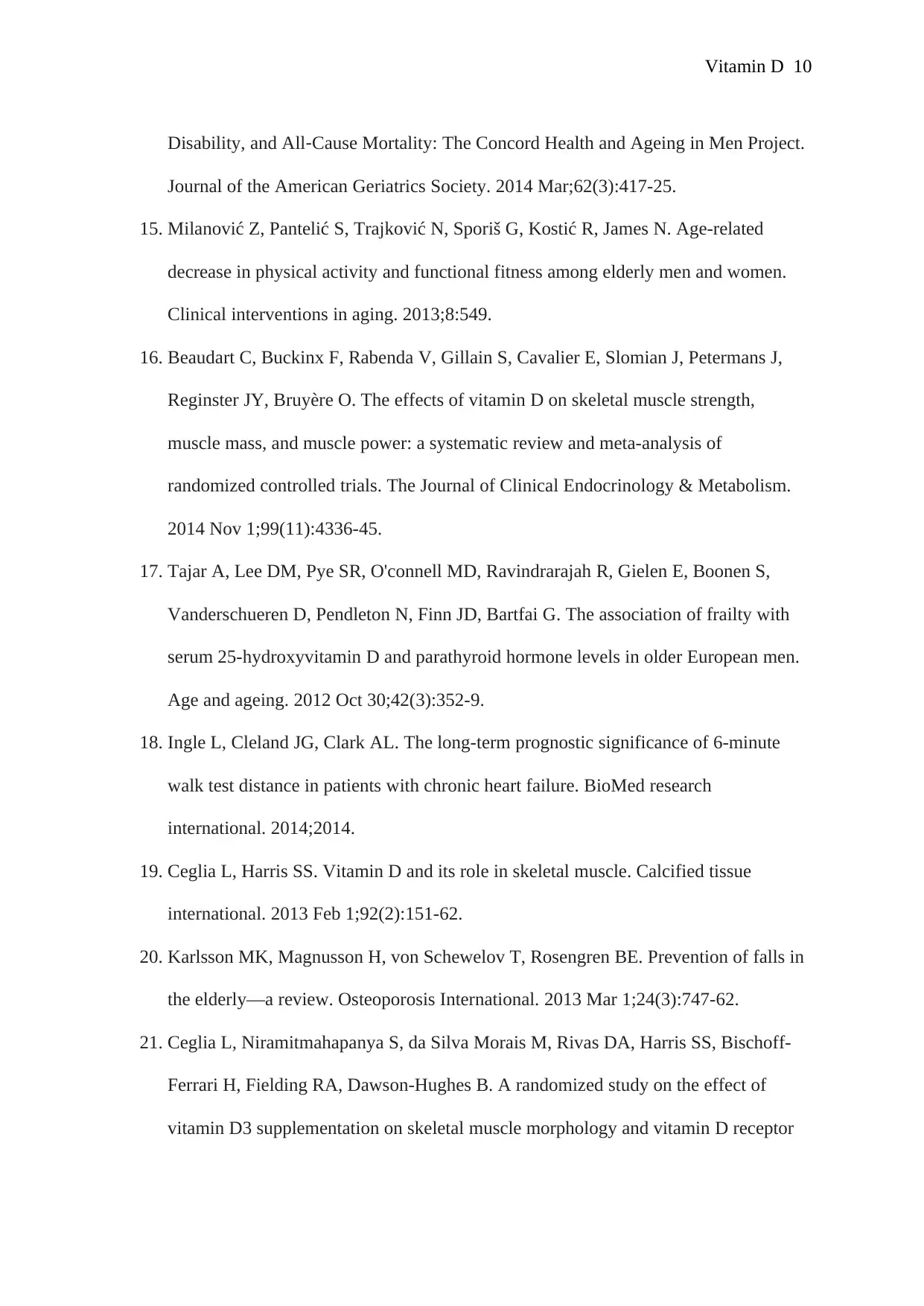
Vitamin D 10
Disability, and All‐Cause Mortality: The Concord Health and Ageing in Men Project.
Journal of the American Geriatrics Society. 2014 Mar;62(3):417-25.
15. Milanović Z, Pantelić S, Trajković N, Sporiš G, Kostić R, James N. Age-related
decrease in physical activity and functional fitness among elderly men and women.
Clinical interventions in aging. 2013;8:549.
16. Beaudart C, Buckinx F, Rabenda V, Gillain S, Cavalier E, Slomian J, Petermans J,
Reginster JY, Bruyère O. The effects of vitamin D on skeletal muscle strength,
muscle mass, and muscle power: a systematic review and meta-analysis of
randomized controlled trials. The Journal of Clinical Endocrinology & Metabolism.
2014 Nov 1;99(11):4336-45.
17. Tajar A, Lee DM, Pye SR, O'connell MD, Ravindrarajah R, Gielen E, Boonen S,
Vanderschueren D, Pendleton N, Finn JD, Bartfai G. The association of frailty with
serum 25-hydroxyvitamin D and parathyroid hormone levels in older European men.
Age and ageing. 2012 Oct 30;42(3):352-9.
18. Ingle L, Cleland JG, Clark AL. The long-term prognostic significance of 6-minute
walk test distance in patients with chronic heart failure. BioMed research
international. 2014;2014.
19. Ceglia L, Harris SS. Vitamin D and its role in skeletal muscle. Calcified tissue
international. 2013 Feb 1;92(2):151-62.
20. Karlsson MK, Magnusson H, von Schewelov T, Rosengren BE. Prevention of falls in
the elderly—a review. Osteoporosis International. 2013 Mar 1;24(3):747-62.
21. Ceglia L, Niramitmahapanya S, da Silva Morais M, Rivas DA, Harris SS, Bischoff-
Ferrari H, Fielding RA, Dawson-Hughes B. A randomized study on the effect of
vitamin D3 supplementation on skeletal muscle morphology and vitamin D receptor
Disability, and All‐Cause Mortality: The Concord Health and Ageing in Men Project.
Journal of the American Geriatrics Society. 2014 Mar;62(3):417-25.
15. Milanović Z, Pantelić S, Trajković N, Sporiš G, Kostić R, James N. Age-related
decrease in physical activity and functional fitness among elderly men and women.
Clinical interventions in aging. 2013;8:549.
16. Beaudart C, Buckinx F, Rabenda V, Gillain S, Cavalier E, Slomian J, Petermans J,
Reginster JY, Bruyère O. The effects of vitamin D on skeletal muscle strength,
muscle mass, and muscle power: a systematic review and meta-analysis of
randomized controlled trials. The Journal of Clinical Endocrinology & Metabolism.
2014 Nov 1;99(11):4336-45.
17. Tajar A, Lee DM, Pye SR, O'connell MD, Ravindrarajah R, Gielen E, Boonen S,
Vanderschueren D, Pendleton N, Finn JD, Bartfai G. The association of frailty with
serum 25-hydroxyvitamin D and parathyroid hormone levels in older European men.
Age and ageing. 2012 Oct 30;42(3):352-9.
18. Ingle L, Cleland JG, Clark AL. The long-term prognostic significance of 6-minute
walk test distance in patients with chronic heart failure. BioMed research
international. 2014;2014.
19. Ceglia L, Harris SS. Vitamin D and its role in skeletal muscle. Calcified tissue
international. 2013 Feb 1;92(2):151-62.
20. Karlsson MK, Magnusson H, von Schewelov T, Rosengren BE. Prevention of falls in
the elderly—a review. Osteoporosis International. 2013 Mar 1;24(3):747-62.
21. Ceglia L, Niramitmahapanya S, da Silva Morais M, Rivas DA, Harris SS, Bischoff-
Ferrari H, Fielding RA, Dawson-Hughes B. A randomized study on the effect of
vitamin D3 supplementation on skeletal muscle morphology and vitamin D receptor
Secure Best Marks with AI Grader
Need help grading? Try our AI Grader for instant feedback on your assignments.
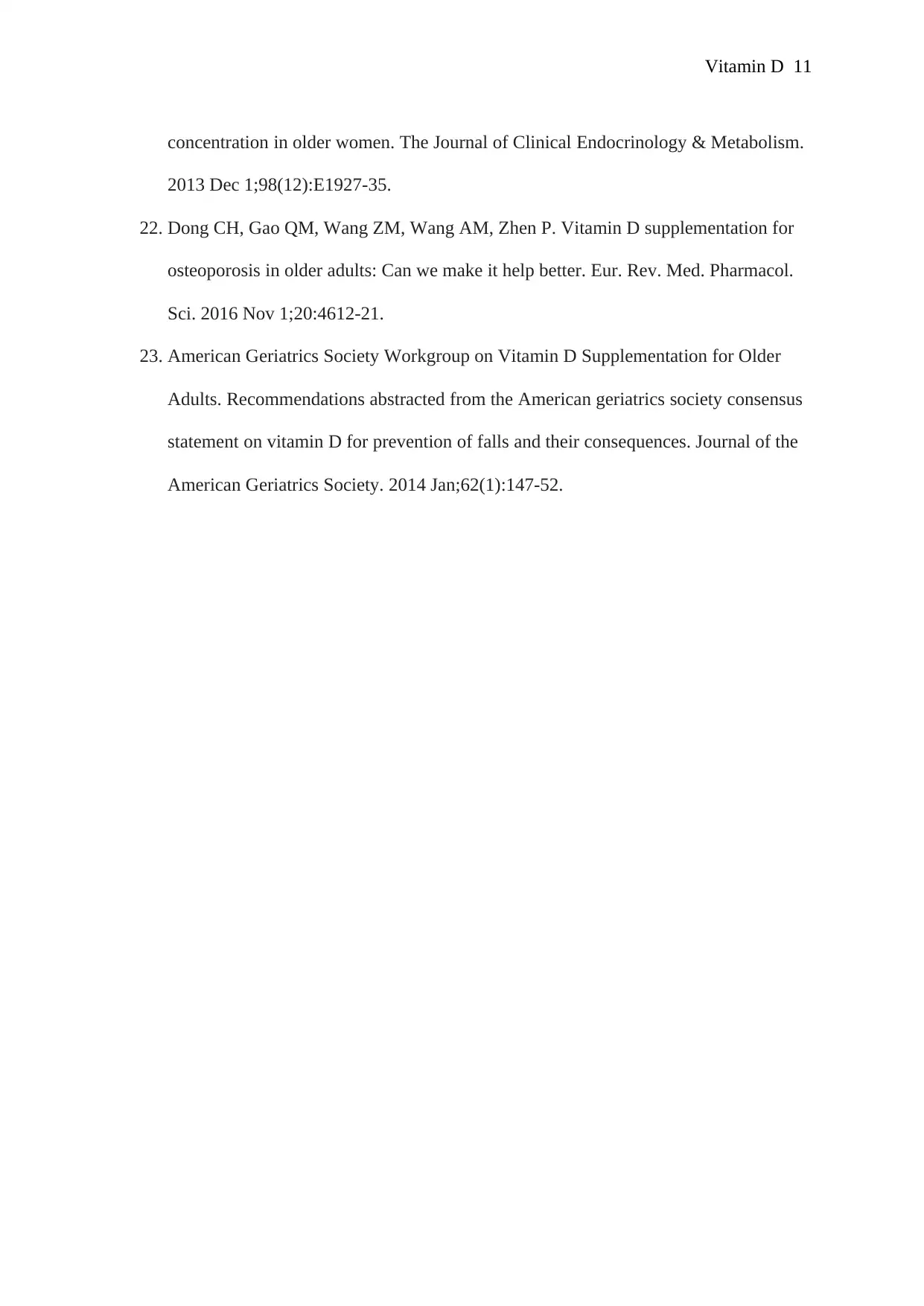
Vitamin D 11
concentration in older women. The Journal of Clinical Endocrinology & Metabolism.
2013 Dec 1;98(12):E1927-35.
22. Dong CH, Gao QM, Wang ZM, Wang AM, Zhen P. Vitamin D supplementation for
osteoporosis in older adults: Can we make it help better. Eur. Rev. Med. Pharmacol.
Sci. 2016 Nov 1;20:4612-21.
23. American Geriatrics Society Workgroup on Vitamin D Supplementation for Older
Adults. Recommendations abstracted from the American geriatrics society consensus
statement on vitamin D for prevention of falls and their consequences. Journal of the
American Geriatrics Society. 2014 Jan;62(1):147-52.
concentration in older women. The Journal of Clinical Endocrinology & Metabolism.
2013 Dec 1;98(12):E1927-35.
22. Dong CH, Gao QM, Wang ZM, Wang AM, Zhen P. Vitamin D supplementation for
osteoporosis in older adults: Can we make it help better. Eur. Rev. Med. Pharmacol.
Sci. 2016 Nov 1;20:4612-21.
23. American Geriatrics Society Workgroup on Vitamin D Supplementation for Older
Adults. Recommendations abstracted from the American geriatrics society consensus
statement on vitamin D for prevention of falls and their consequences. Journal of the
American Geriatrics Society. 2014 Jan;62(1):147-52.
1 out of 11
Related Documents
Your All-in-One AI-Powered Toolkit for Academic Success.
+13062052269
info@desklib.com
Available 24*7 on WhatsApp / Email
![[object Object]](/_next/static/media/star-bottom.7253800d.svg)
Unlock your academic potential
© 2024 | Zucol Services PVT LTD | All rights reserved.



